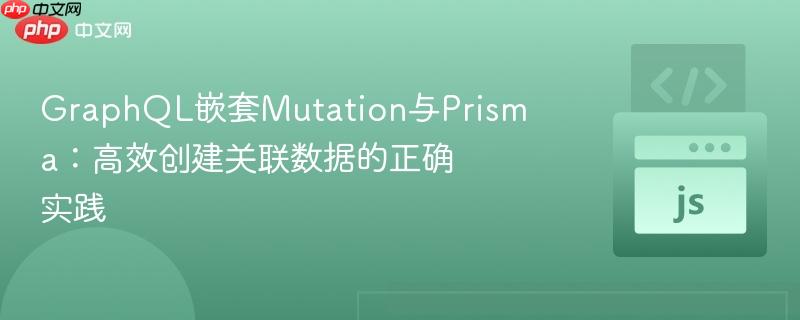
本文深入探讨了在GraphQL应用中,如何利用嵌套Mutation与Prisma ORM协同工作,实现用户与关联档案等数据的同步创建。核心在于明确区分GraphQL输入类型定义与Prisma客户端的关联数据操作语法,避免在客户端Mutation中误用`create`关键字,从而解决“字段未提供”的常见错误,确保数据创建流程的顺畅与高效。
在构建现代Web应用时,我们经常需要同时创建或更新具有关联关系的数据。例如,当一个新用户注册时,我们可能不仅要创建用户记录,还要同时创建其对应的用户档案(Profile)。GraphQL的嵌套Mutation结合Prisma ORM的强大功能,为我们提供了优雅的解决方案。然而,在实际操作中,开发者常因对GraphQL输入类型与Prisma操作语法的混淆,导致“字段未提供”的错误。
假设我们有一个User模型和一个与之关联的Profile模型(一对一关系),我们希望通过一个Mutation同时创建它们。
GraphQL Schema 定义:
input addUserInput {
firstName: String!
middleName: String
lastName: String
username: String!
email: String
roleId: String!
password: String
profile: addProfileInput # 注意这里,profile直接是addProfileInput类型
}
input addProfileInput {
addressOne: String!
addressTwo: String!
zip: String!
dob: String!
}
type Mutation {
signUp(input: addUserInput!): AuthPayload
}后端Prisma Resolver 实现:
// 部分代码,仅展示关键逻辑
signUp: async (_, { input }) => {
const password = await hash(input.password, 10);
const newUser = await prisma.user.create({
data: {
firstName: input.firstName,
// ...其他用户字段
password,
profile: {
create: { // 这里使用了Prisma的`create`关键字
addressOne: input.profile.addressOne,
addressTwo: input.profile.addressTwo,
zip: input.profile.zip,
dob: input.profile.dob,
},
},
},
include: {
profile: {
select: {
dob: true,
},
},
},
});
return newUser;
},客户端错误的Mutation尝试:
mutation {
addUser(
input: {
firstName: "Jane"
lastName: "Doe"
roleId: "bfb3d29a-379e-4558-b2fd-af98b666c100"
username: "jdoe"
email: "jane.doe@example.com"
password: "1234567890"
profile: { # 错误点:在这里添加了`create`层级
create: {
addressOne: "Runda, Kenya"
addressTwo: "Murang'a, Kenya"
dob: "12-12-1990"
zip: "22333-00100"
}
}
}
) {
id
firstName
lastName
profile {
id
dob
}
}
}执行上述Mutation时,你会收到类似 "message": "Field \"addProfileInput.addressOne\" of required type \"String!\" was not provided." 的错误。这是因为GraphQL服务器根据addUserInput的定义,期望profile字段直接接收一个addProfileInput类型的数据,而不是一个包含create字段的对象。客户端提供的Mutation结构与Schema定义不符,导致解析失败。
问题的核心在于混淆了GraphQL输入类型定义与Prisma ORM在解析器中处理关联数据的语法。
因此,客户端发送的Mutation数据结构必须严格遵循GraphQL Schema的定义。
正确的客户端Mutation结构:
mutation {
signUp( # 注意这里Mutation名称与Schema定义保持一致
input: {
firstName: "Jane"
lastName: "Doe"
roleId: "bfb3d29a-379e-4558-b2fd-af98b666c100"
username: "jdoe"
email: "jane.doe@example.com"
password: "1234567890"
profile: { # 直接提供addProfileInput类型的数据
addressOne: "Runda, Kenya"
addressTwo: "Murang'a, Kenya"
dob: "12-12-1990"
zip: "22333-00100"
}
}
) {
id
firstName
lastName
profile {
id
dob
}
}
}通过移除客户端Mutation中profile字段下的create: {}层级,数据结构现在与addUserInput中profile: addProfileInput的定义完全匹配。GraphQL服务器将正确解析这个输入,并将其传递给后端解析器。后端解析器中的Prisma create操作(profile: { create: { ... } })将接收到input.profile中的数据,并按照预期创建关联的Profile记录。
区分职责:
Schema驱动开发: 始终以GraphQL Schema为中心进行开发。客户端Mutation的结构必须与Schema中定义的输入类型保持一致。
解析器(Resolver)是桥梁: 解析器负责将GraphQL的请求(经过Schema验证的输入)转换为Prisma或其他数据源的操作。它承担了转换和执行业务逻辑的责任。
关联类型操作: Prisma提供了多种处理关联数据的方法,例如:
通过本教程,我们深入理解了在GraphQL应用中,结合Prisma ORM进行嵌套Mutation时,如何正确处理客户端输入与后端解析器逻辑。关键在于确保客户端发送的数据结构严格符合GraphQL Schema的定义,而Prisma特有的关联数据操作(如create)则是在后端解析器中被调用和执行的。遵循这一原则,将有效避免“字段未提供”等常见错误,从而构建出更加健壮和高效的GraphQL API。
以上就是GraphQL嵌套Mutation与Prisma:高效创建关联数据的正确实践的详细内容,更多请关注php中文网其它相关文章!

每个人都需要一台速度更快、更稳定的 PC。随着时间的推移,垃圾文件、旧注册表数据和不必要的后台进程会占用资源并降低性能。幸运的是,许多工具可以让 Windows 保持平稳运行。

Copyright 2014-2025 https://www.php.cn/ All Rights Reserved | php.cn | 湘ICP备2023035733号